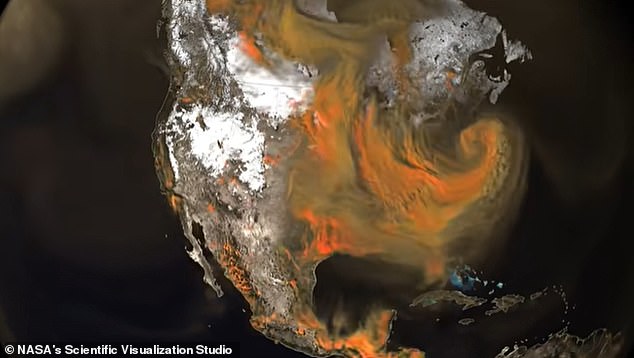It is the most abundant greenhouse gas and is warming the Earth at an alarming rate.
Now, incredible new images show the huge masses of carbon dioxide (CO2) that are fueling climate change.
NASA satellites have detected swirling gas, which is emitted by power plants, wildfires, cattle raised for meat and much more.
Of course, CO2 is invisible, but NASA’s Scientific Visualization Studio experts have colored it bright orange to make it clearer.
In the clip, the gas appears in fascinating “pulses” as the world spins and day turns to night.
NASA video shows carbon dioxide concentrations as the gas moved through Earth’s atmosphere between January and March 2020.
“As policymakers and scientists, we’re trying to figure out where carbon is coming from and how it impacts the planet,” said climate scientist Lesley Ott at NASA’s Goddard Space Flight Center in Greenbelt, Maryland.
“This is where you see how everything is interconnected by these different weather patterns.”
Satellites positioned in space have instruments called spectrometers that detect and monitor greenhouse gases such as CO2.
NASA’s global map shows CO2 concentrations as the gas moved through Earth’s atmosphere from January to March 2020, driven by wind patterns and atmospheric circulation.
As the video zooms in, emissions can be seen rising from power plants, fires and cities, then spreading across continents and oceans.

More intense emissions (with a higher intensity of CO2 molecules) appear as a deeper reddish orange color.

Carbon dioxide (CO2) is a heat-trapping greenhouse gas and is the main cause of rising temperatures on Earth. As CO2 builds up in the atmosphere, it warms our planet.
During that period, most emissions from China, the United States and South Asia came from power plants, industrial facilities and vehicles.
Meanwhile, in Africa and South America, most CO2 emissions come from fires, especially those related to land management, controlled agricultural burning and deforestation, along with the burning of fossil fuels, oil and coal.
Trees absorb and store CO2 from the air, so they release the gas in large quantities when they burn.
In the video, CO2 appears in “pulses,” which is largely due to polluting human activity that takes place mainly during the day.
For example, forest fires often start during the day and are extinguished at night, while most vehicles (which emit CO2 from their exhausts) also make journeys during the day.

As the world spins, the gas appears in fascinating “pulses” as day turns to night. Of course, CO2 is invisible, but experts at NASA’s Scientific Visualization Studio have turned it bright orange to see it clearly.
Of course, CO2 isn’t the most potent greenhouse gas: that’s methane (CH4), which comes from burning fossil fuels, decomposing landfill waste, and more.
Scientists say methane has a global warming potential 28 times greater than CO2, although fortunately it is not released as abundantly as CO2.
However, scientists generally agree that the Earth is heading toward climate disaster as humans fail to sufficiently reduce emissions.
Over time, the planet will become too hot due to the greenhouse effect, leading to widespread heat exhaustion and death, flooding in coastal cities due to ice buildup at the poles and food shortages, they believe.
United Nations Secretary-General Antonio Guterres has said we are “on a highway to climate hell with our foot on the accelerator.”



